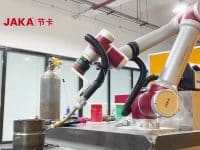Robotics palletizing system has been used in almost every industrial manufacturing setting globally. The repetitive and dangerous tasks of organizing boxes and item on a pallet cause companies to start implementing robotics palletizing system. To understand more about robotics palletizing system, learn more about these 10 important things.
1. Criteria in Selecting the Right Robot for the Job
In considering which robot is right for the job, you need to identify these 4 criteria:
Reach. The distance from the center of the robot to the longest extension of the arm.
Payload. In selecting payload, you need to remember that payload must include the weight of the end of the arm tool as well as the product it is handling and it should be determined at the center of the faceplate.
Speed. Speed involves calculating the rotation speeds for each axis. It is bet to be computed many times through a simulation.
Axes. In average, 4-axis robot is sufficient because products are usually picked up from the floor and put on the pallets. If products need to be rotated or tilted, then 5 or 6 axis robots can be used.
2. Things to Help Enhance Your System
There are a few things that you can enhance in addition to integrating this system. You can do this by performing the following:
- Integrating robot vision.
- Callback to measure when products are
picked and places. - Software for enhancing safety of the
robots use. - Other palletizing software.
3. Being Flexible to Suit New Uses
Many times we might need to readjust our robotics palletizing system to suit the ever-changing needs that our company has such as changes in the nature of consumer goods, or if there are new specifications coming up with the products that are served. Hence, it is important to study how we can flexibly use our system to adjust to these new needs.
4. Less Maintenance Cost
Robots palletizing system involves the use of robots which are mostly iron arms and servo motors. Most of these have less number of moving parts and thus, require less maintenance.
5. Design of the End of Arm Tool
The end of arm tool is the last thing to touch a customer’s product before the customer receives it. Hence, it is very important that designing it so that it can handle gently, reliably, and effect is very critical in designing a successful robotic palletizing system. Some forms that end of arm tools can be are: zoned vacuum cups, clam shell or claw grippers, and many others.
6. Determining Number of Lines Each Robot Should Handle
Each robot that has a wide reach might able to handle multiple production lines simultaneously. The most common configurations are 1-in/1-out, 2-in/2-out, 3-in/3-out and 4-in/4-out systems. The cost of implementing this tend to increase as more production lines are being handled. In addition, it is important to take account the speed and space in doing handling these production lines.
7. Combining with Other Robots
Adding additional robots so that it can collaborate with the existing palletizing robot system has become the new trends. These collaborations are usually separated using the role of each robot.
8. Cost of Implementation
The cost of implementation of robotic palletizing system has become very much affordable as the prices of the robotic components drop and robotic knowledge has become widely available. Comparing this with the rising cost of labor, needs for safe working environments and keeping operations effective, investing in this system proves to be useful.
9. Always Monitor Utilizations
It is easy to get swayed by the trend of using robotics system. However, the most important thing is to ensure that each robotic system being implement is utilized efficiently and provides better system to the company overall. Therefore, it is important to monitor the utilization of this system frequently to ensure that efficiency and effectiveness of the system is being optimized all the time.
10. Proper Integration is the Key
With that, it is very important that proper integration of this system is done by a well experienced consultant or engineering company. One must understands the requirements, needs, and use the specifications of each robotic palletizing system to fulfill these requirements and needs.
Knowing these 10 things, we hope that it will help you give clearer direction on your plan to implement robotic palletizing system. If you have any question or needs some consultation about this, please do not hesitate to contact us.




